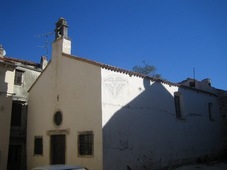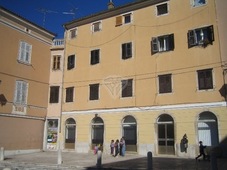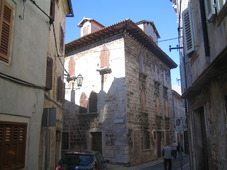to enlarge


or choose the place
from the menu below
 Rome |
 Byzantium |
 Venice |
 Vienna |
 Brioni |
 Smrikve |
 |
 |

If you take the narrow road that goes towards north, on the crossroad with the Municipal building, you will arrive near to one of the oldest building in Vodnjan. It is the Church of St. Jacob and the Holy Trinity from the 9th century. In Italian the name of this church that was translated as the Holy Trinity is “Trisiere” and is assumed that this name derives from the Greece word “Tres Xieras”.
Istria was for almost three centuries part of the Byzantine Empire and the cult of the Holy Trinity was important in the Byzantine culture. Some sources tell us that in origin the name of this church was dedicated to the three Saints of the Holy Trinity so probably the origin of the name could be “Tres Xieras”.
This building is of particular importance for Vodnjan because in 1393 hosted the stipulation of the peace agreement between Pula and Vodnjan.
In addition, in 1492, when Columbus discovered America, the statute of Vodnjan was approved in this church by all the heads of the families living at the time in Vodnjan.
Many Istrian towns have several centuries old statutes. The roots of this representation of the civil government of the towns in Istria dates back in the Roman Republic times and the spirit of this civil institution have not been destroyed completely neither during the long Middle Ages period. Thanks to Venice it has returned to its citizens in several Istrian towns already in the 13th century.
 If you turn back to the main square
and look at the building that is opposite to the former Public palace, always on the northern side of the square, you will
see the building that hosted the second fontico, a granary storage house, of Vodnjan.
If you turn back to the main square
and look at the building that is opposite to the former Public palace, always on the northern side of the square, you will
see the building that hosted the second fontico, a granary storage house, of Vodnjan.
There are two other roads that you can take from the main square. The first one goes nearby the former Public palace and the second one goes towards west and towards the Parish Church of St. Blaise.
If you take the second direction, in the place where the main square ends and a new street starts, take a look towards the building with stone made façade and one of the most beautiful balcony in Vodnjan and probably in Istria with interesting Venetian Gothic “bifora” windows.
The building has a big vault on the right side of the façade. The whole building, if you look carefully at it, is a beautiful example of architecture art that respects symmetry and proportions although the façade followed the curvy road.
 Twenty meters from there, on the left side of the street, you can enjoy another architectural
beauty. It is Betica palace and now museum that dates back into 1300. This palace in the
Portarol street has same Renaissance elements like the window you can see on the first floor. Also the wall of the court yard
has Ghibelline crenulations like those in Florence.
Twenty meters from there, on the left side of the street, you can enjoy another architectural
beauty. It is Betica palace and now museum that dates back into 1300. This palace in the
Portarol street has same Renaissance elements like the window you can see on the first floor. Also the wall of the court yard
has Ghibelline crenulations like those in Florence.
There is a story linked with this palace that say how every person that had problems with justice if it was able to find protection in this house would have gained the immunity.
As you have seen there are several nice stone made facades in Vodnjan. There are also some nice building in Decumano street in Porec but what I would like to underline that only the most wealthy family were able to built building like Betica palace, or Gonano Parisi palace in Porec, or Salomon palace in Gracisce as examples. Only these rare beauties had stone made facades and they were very expensive.